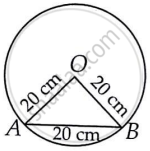Advertisements
Advertisements
Question
In a circle of diameter 40 cm, the length of a chord is 20 cm. Find the length of minor arc of the chord.
Solution

Triangle OAB is an equilateral triangle ∠AOB = 60°
= `(60×π)/180 "radians"`
= `π/3` radian
Let arc AB = l
The angle made by the arc at centre O, θ = `π/3` Length of arc AB,
l = rθ = 20 × `π/3` radians
= `(20π)/3` radians
APPEARS IN
RELATED QUESTIONS
Find the radian measure corresponding to the following degree measure:
– 47° 30'
Find the radian measure corresponding to the following degree measure:
240°
Find the radian measure corresponding to the following degree measure:
520°
Find the degree measure corresponding to the following radian measure (Use `pi = 22/7`)
-4
Find the degree measures corresponding to the following radian measures (Use `pi = 22/7`)
`(5pi)/3`
Find the degree measure of the angle subtended at the centre of a circle of radius 100 cm by an arc of length 22 cm
(Use `pi = 22/7`)
Find the angle in radian through which a pendulum swings if its length is 75 cm and the tip describes an arc of length
15 cm
Find the angle in radian through which a pendulum swings if its length is 75 cm and the tip describes an arc of length
21 cm
Find the degree measure corresponding to the following radian measure:
\[\frac{9\pi}{5}\]
Find the degree measure corresponding to the following radian measure:
\[- \frac{5\pi}{6}\]
Find the degree measure corresponding to the following radian measure:
11c
Find the radian measure corresponding to the following degree measure:
300°
Find the radian measure corresponding to the following degree measure: −56°
Find the radian measure corresponding to the following degree measure: 7° 30'
Find the radian measure corresponding to the following degree measure: 125° 30'
The difference between the two acute angles of a right-angled triangle is \[\frac{2\pi}{5}\] radians. Express the angles in degrees.
One angle of a triangle \[\frac{2}{3}\] x grades and another is \[\frac{3}{2}\] x degrees while the third is \[\frac{\pi x}{75}\] radians. Express all the angles in degrees.
Find the magnitude, in radians and degrees, of the interior angle of a regular octagon.
Find the magnitude, in radians and degrees, of the interior angle of a regular heptagon.
The angles of a triangle are in A.P. such that the greatest is 5 times the least. Find the angles in radians.
The number of sides of two regular polygons are as 5 : 4 and the difference between their angles is 9°. Find the number of sides of the polygons.
A wheel makes 360 revolutions per minute. Through how many radians does it turn in 1 second?
A railway train is travelling on a circular curve of 1500 metres radius at the rate of 66 km/hr. Through what angle has it turned in 10 seconds?
Find the diameter of the sun in km supposing that it subtends an angle of 32' at the eye of an observer. Given that the distance of the sun is 91 × 106 km.
Find the degree measure of the angle subtended at the centre of a circle of radius 100 cm by an arc of length 22 cm.
If D, G and R denote respectively the number of degrees, grades and radians in an angle, the
At 3:40, the hour and minute hands of a clock are inclined at
If OP makes 4 revolutions in one second, the angular velocity in radians per second is
A circular wire of radius 7 cm is cut and bent again into an arc of a circle of radius 12 cm. The angle subtended by the arc at the centre is
A circular wire of radius 3 cm is cut and bent so as to lie along the circumference of a hoop whose radius is 48 cm. Find the angle in degrees which is subtended at the centre of hoop.
If θ lies in the second quadrant, then show that `sqrt((1 - sin theta)/(1 + sin theta)) + sqrt((1 + sin theta)/(1 - sin theta))` = −2sec θ
“The inequality `2^sintheta + 2^costheta ≥ 2^(1/sqrt(2))` holds for all real values of θ”
The value of cos1° cos2° cos3° ... cos179° is ______.
Which of the following is correct?
[Hint: 1 radian = `180^circ/pi = 57^circ30^'` approx]
State whether the statement is True or False? Also give justification.
Sin10° is greater than cos10°
State whether the statement is True or False? Also give justification.
`cos (2pi)/15 cos (4pi)/15 cos (8pi)/15 cos (16pi)/15 = 1/16`
